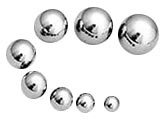|
Ball
Size
Nominal Diameter
The diameter used for general identification of a ball
size, indicated either in fractions of an inch or in millimeters.
For example: 1/4", 1/2" or 1 mm, 7 mm, etc.
Ball Gage
The prescribed small amount by which the lot mean diameter
should differ from the nominal diameter, the amount being
one of an established series of amounts. Ball gage is
expressed as a decimal variation (usually ten thousandths
of an inch) , e.g. +.0003 (P3) or -.0001 (M1). A ball
gage, in combination with the ball grade and nominal diameter,
should be considered as the most exact ball size specification
to be used by a customer for ordering purposes because
a slight increase or decrease of the nominal size is sometimes
needed to fulfill application requirements. For instance,
bearing races that are specified to accept a 1/2"
nominal or "OK" ball may actually be over or
undersized by a small fraction and the use of a 1/2"
OK ball would cause the loss of some tolerance in the
bearing. Adding a positive or negative ball gage increment
will result in balls that fit the exact measurement of
the finished bearings.
Basic Diameter
The ordered size of a ball lot. It is usually expressed
as the nominal diameter plus ball gage. For example, 1/2
(P3) is the basic diameter of a ball lot having a mean
diameter of .5003 or 1/2" +.0003". Basic diameter
is the size to which the basic diameter tolerance will
apply.
Basic Diameter Tolerance
A function of grade as applied to basic diameter, describing
the allowable range of size within a particular grade.
For instance, grade 24 balls have a basic diameter tolerance
of ±.000100".
Marking Increment
The standard unit steps in micrometers or in millionths
of an inch, used to express the specific diameter.
Specific Diameter
The specific diameter is the mean diameter of a ball lot,
as determined through actual measurement of a sampling
from the lot shipped and marked on the unit container.
It will fall within a dimensional tolerance around the
basic diameter according to grade and is expressed in
the grade's marking increment nearest to the average diameter
of the balls in that container.
Grades and Tolerances
Ball Grade
The guaranteed sphericity expressed in millionths of an
inch. For example, a grade 24 ball is spherically accurate
within 24 millionths of an inch. The grade designation
also indicates dimensional tolerances per allowable lot
diameter variance.
Lot Diameter Variation
The difference between the mean diameter of the largest
ball and that of the smallest ball in the lot. In other
words, it is the permissible range of average diameters
of individual balls within any one lot.
Lot
A definitive quantity of balls manufactured under conditions
which are presumed uniform and which is considered and
identified as an entirety.
Ball Diameter Tolerance
The maximum allowable deviation of any ball lot mean diameter
from the nominal ball diameter.

Surface Qualities (Evaluated
per ANSI B46.1)
Surface Roughness (Ra)
Surface roughness is a numerical value of the mean roughness
height or amplitude measured from the roughness centerline.
It is approximately half of the average distance from
peak to valley.
Sphericity (Roundness)
The difference between the largest diameter and the
smallest diameter measurable on a single ball. In other
words, it is the radial distance of the maximum peak
from the perfect circle plus the distance of the maximum
valley from the perfect circle.
Surface Waviness
Geometric irregularity of the ball surface where the
wave lengths are longer than those found in surface
roughness. The more widely spaced circumferential component
of surface texture.
Visual inspection
Observation of the ball surface by the naked eye. Also
called macroscopic inspection.
Mechanical characteristics
Case Depth
This term is applicable to case hardened balls only.
The distance from the surface of the ball to the unhardened
core for low carbon steel balls. It is measured radially
from the surface to a point where the hardness becomes
Rockwell "C" 50 (Reference ANSI/ABMA Std 10-1983)
Hardness
The resistance of balls to penetration.
|



